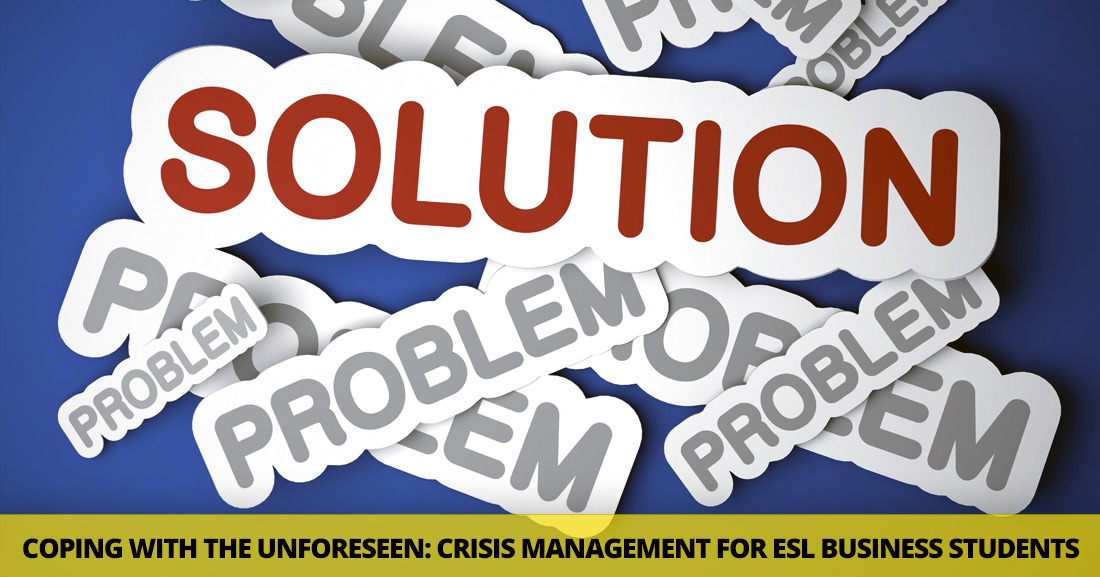Coping With the Unforeseen: Crisis Management for ESL Business Students


My school was struggling to hire ESL Business teachers, so I volunteered. I’m not trained in business or economics, but I found that a few hours’ research equipped me sufficiently to guide ESL students through the most important topics. Ultimately, it’s just another subject area, like the weather, or sports, or family life, and if you’re looking for a fresh challenge, I encourage you to give it a try.
I’m a huge fan of using role-plays and authentic, real-world scenarios to give my students practice in the vocabulary and concepts we’re studying. I adapt these scenarios from textbooks, but most often, I design my own. This lets me bring in recent events and highly relevant topics (at the time of writing in 2016, for example, I’m working on a management exercise related to the European migration crisis, and a negotiation task based on the Paris climate change accords). Creating these scenarios is not nearly as time-consuming as you might think, and can follow a reliable pattern:
You have a broad choice here, but I tend to narrow the subject areas down to include:
Track the fictional events from the beginning. What happened, when, and why? Who was involved? Begin creating a short list of the key characters – executives, department heads, a spokesperson, a politician, an expert, a journalist, a member of the public, etc.
For example: Convivia spent years polluting the River Weston with run-off from their pesticide facility, but had been successfully bribing the local environmental regulators to keep the situation quiet. A new and idealistic chief regulator is appointed, and immediately blows the lid off the scandal. Convivia now faces massive fines, and must begin a damage limitation exercise, as well as demonstrating contrition and offering compensation to local fishermen.
Write a role card for each participant, explaining in sufficient detail their responsibilities and aims in this process. I tend to organize my students into groups of 4-6, with sufficient roles for one per person.
I like scenarios which develop as my students make decisions. This can, of course, become very complicated (somewhat in the manner of a ‘Choose Your Own Adventure’ story) but you can also keep things very simple. Decide on one or two external events – an article appearing in the media, a witness coming out of hiding, the release of an important report, etc – which will throw a wrench in your students’ carefully crafted plans.
Here’s an example from one of my favorite exercises, United Nations, which I ran recently with an upper-intermediate class in Boston:
| Teacher: | OK, so it seems as though you’ve got a solid agreement on compensation for the villagers whose homes were destroyed in the incursion. Am I right on that? |
| Team 1: | Yes! |
| Team 2: | Yes! / It’s not bad / It’s good enough for now. |
| Teacher: | Awesome. Well, I’m afraid I’ve got some breaking news… |
| Team 2: | Again? / What now? |
| Teacher: | There’s been a firefight at the border. Two of Team Two’s soldiers are missing. |
| Team 2: | Missing? Are they dead or alive? |
| Team 1: | What happened? |
| Teacher: | It seems that Team One has captured these two soldiers. |
| Team 2: | Terrible! Must give them back! |
| Teacher: | OK, well, Team Two, get ready to negotiate for their return. Team One, you hold the upper hand now, so decide what you’d accept in return for these two soldiers. Talk again in five minutes? |
| Teams: | OK! |
The two teams then huddle up and concoct their plan. These unexpected changes of direction add an air of dynamic, unpredictable realism to the exercise, and require my students to think on their feet and discuss the problem from new angles.
Feel free to toss in some surprises like this, but only perhaps one or two per exercise.
Beyond simply producing tons of the target language and practicing the concepts of crisis management, these scenarios should have a logical end point. In the case of the United Nations task, we continue negotiating until we have a comprehensive agreement between the two nations. In the case of another favorite of mine, Shark Attack, the class must come together and design an action plan to mitigate the effects of further attacks on a small beach town which depends on tourism, and then write a press release informing the public of their plans.
At the end of the exercise, reflect on the decisions your students made, the effects they had, and how they might have achieved a better solution. Did they push too hard at any stage, or perhaps not demand enough from the opposing team? Were they flexible enough when responding to events? How would they do things differently, given the chance?
I like to encourage teachers to become creative with their material, both to provide a welcome break from the textbook, and so that they can craft exercises which respond very specifically to the learning needs and interests of their class. My students always respond well when they realize I’ve written something especially for them, and it never takes longer than a couple of hours to put together, once you’ve been through the process a few times. The flexibility to address contemporary issues, and to practice specific language skills, is well worth the time invested, and you’ll soon build up a personal library of terrific, evolving exercises.